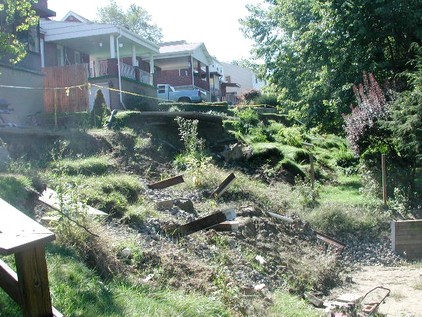PENNSYLVANIA'S GEo-hazards

We may not have the earthquakes of California or the tornadoes of Kansas or the hurricanes of the Atlantic coast, but we do have the potential for landslides, flooding, subsidence and natural gas migration.
A Stray Gas Workshop was held on November 4-6, 2009 here in Pittsburgh sponsored by the U.S. Geological Survey Pennsylvania Water Sc ience Center in cooperation with the Office of Surface Mining, Reclamation, and Enforcement, U.S. Department of the Interior, PA Department of Environmental Protection and the Pittsburgh Geological Society. This workshop focused on the scientific basis for the assessment and analysis of stray or fugitive gases such as methane (the primary component of natural gas) or carbon dioxide.
Tools and strategies for investigating stray gases, along with case studies, were presented by scientists and specialists whose work has focused on the origins, migration, and accumulation of gases. The workshop presentations had emphasis on carbon dioxide and methane; the implications for safety, mitigation, and management of subsurface resources also were addressed. You are invited to view the presentations from the workshop on the USGS website under the "Workshop Presentations" tab .
Landslides
Every year brings new examples of landsliding in Pittsburgh's neighborhoods. Although many factors can contribute to a landslide, chief among them is the presence of Pittsburgh red beds, steep topographic slopes and water lubricating the failure zone. The Pittsburgh red beds are a red shale and claystone rock layer that weathers to a clay.
Groundwater can saturate the clay to such a degree that it can not maintain its slope and begins to move downhill. On our hillslopes are examples of historic landslides that occurred before man arrived. And we have examples of landslides aggravated by the activities of man. Read a more in-depth paper on the characteristics and causes of landslides by clicking on the link below.
To view documents on southwestern Pennsylvania's geological hazards, click below.
A Stray Gas Workshop was held on November 4-6, 2009 here in Pittsburgh sponsored by the U.S. Geological Survey Pennsylvania Water Sc ience Center in cooperation with the Office of Surface Mining, Reclamation, and Enforcement, U.S. Department of the Interior, PA Department of Environmental Protection and the Pittsburgh Geological Society. This workshop focused on the scientific basis for the assessment and analysis of stray or fugitive gases such as methane (the primary component of natural gas) or carbon dioxide.
Tools and strategies for investigating stray gases, along with case studies, were presented by scientists and specialists whose work has focused on the origins, migration, and accumulation of gases. The workshop presentations had emphasis on carbon dioxide and methane; the implications for safety, mitigation, and management of subsurface resources also were addressed. You are invited to view the presentations from the workshop on the USGS website under the "Workshop Presentations" tab .
Landslides
Every year brings new examples of landsliding in Pittsburgh's neighborhoods. Although many factors can contribute to a landslide, chief among them is the presence of Pittsburgh red beds, steep topographic slopes and water lubricating the failure zone. The Pittsburgh red beds are a red shale and claystone rock layer that weathers to a clay.
Groundwater can saturate the clay to such a degree that it can not maintain its slope and begins to move downhill. On our hillslopes are examples of historic landslides that occurred before man arrived. And we have examples of landslides aggravated by the activities of man. Read a more in-depth paper on the characteristics and causes of landslides by clicking on the link below.
To view documents on southwestern Pennsylvania's geological hazards, click below.




